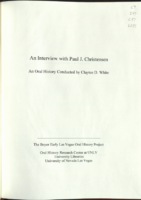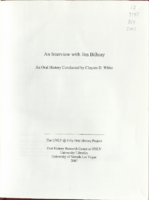Search the Special Collections and Archives Portal
Search Results

Transcript of interview with Miriam Belmont by Laurie Brower, March 8, 1975
Date
1975-03-08
Archival Collection
Description
Laurie Brower interviews Miriam Belmont (b. 1923), who moved to Nevada in 1928, at her home in Las Vegas. Brower, Belmont, and Belmont’s son are all present during the entirety of the interview. During the interview Belmont discusses her move to Las Vegas, various occupations, education, addresses, church involvement, Hoover Dam, famous people, atomic testing, Old Ranch Country Club in Southern California, and the ways in which Las Vegas had changed since she first arrived.
Text

Transcript of interview with Charles A. Bennett by Michael Kulwin, March 5, 1979
Date
1979-03-05
Archival Collection
Description
Michael E. Kulwin interviews co-worker Charles A. Bennett (b. 1914) at his home. Bennett discusses early gaming figures, real estate, Howard Hughes, and casino development. Bennett also weighs in on the Carol Lombard plane crash tragedy, and the early atomic bomb tests conducted in Nevada.
Text

Transcript of interview with Paul J. Christensen by Claytee D. White, February 19, 2008
Date
2008-02-19
Archival Collection
Description
Personal history of Las Vegas through the eyes of a public servant. Growing up in Las Vegas during the 1940s. Education history and childhood memories. Downtown. Experiences in the US Air Force: flying B-47s loaded with nuclear bombs; training. NV Test Site. Family jewelry business in Las Vegas. Election to the board of the Las Vegas Chamber of Commerce. Election to the Las Vegas City Council and the beginning of a career in politics. Jam auction. Tussle with the Clark County Commission over wastewater in the valley: details of the dispute, extended to the state and Environmental Protection Agency. Move to the County Commission and why? The Mob during the 1950s and 60s. The Mormon community in Las Vegas. Howard Hughes. Experiences sitting on the County Commission. Chairman of the Convention Authority. Remarks on Las Vegas' future water supply. Election defeat. Corruption on the County Commission (Erin Kenny). Distinguished Nevadan award. County Hospital. Quick Care Centers. Opinion on the growth of Las Vegas. Speedway Children's Charities. Dina Titus. Experiences with African Americans. Lucy Stewart. Beaver, NV.
Text

Transcript of interview with Robert Francis Bergin by Paula Morey, March 5, 1981
Date
1981-03-05
Archival Collection
Description
Paula Morey interviews a former Desert Inn pit boss, Robert Francis Bergin (b. 1891), at his residence (a motel room) on March 5, 1981. During the interview Bergin discusses his personal history, the opening of the Desert Inn and other casinos, the gambling industry, his visits to Cuba, Wilbur Clark, Howard Hughes, and women in gaming.
Text

Transcript of interview with Lydia Berry by Kathy Zeller, February 22, 1979
Date
1979-02-22
Archival Collection
Description
Lydia Berry, born in Missouri in 1914, is interviewed by Kathy Zeller about her experiences as a worker for the United States Fish and Wildlife Service. Berry discusses her progression from being a teacher in Kansas City to moving to Los Angeles and then to Las Vegas, where she worked at Nellis Air Force Base and then eventually to the Fish and Wildlife Service. She also mentions some of the operations of the Wildlife Service as well as her concerns over animal life and natural resources.
Text

Transcipt of interview with John M. Beville by George Braver, March 11, 1981
Date
1981-03-11
Archival Collection
Description
George Braver interviews John M. Beville (b. 1906) at his home in Las Vegas on March 11, 1981. Braver discusses his move to Nevada in 1926, his personal history, and early banking in Nevada leading up to modernized banking. Beville also discusses his personal experience in the banking business, working in Hollywood as a singer, and brings to the forefront key moments of his life in Nevada.
Text

Transcript of interview with Lt. Col. Jane A. Bigelow by Rebecca Shurley, November 05, 1985
Date
1985-11-05
Archival Collection
Description
Rebecca Shurley interviews Lieutenant Colonel Jane A. Bigelow, born in Buffalo, New York in 1943, about her career as a nurse in the Air Force. Bigelow discusses her experiences mainly as a flight nurse and its unique challenges as well as her experiences in the intensive care unit during the Vietnam War. She provides details on her career progression from staff nurse to her then current position of chief nurse of the United States Air Force Hospital at Nellis Air Force Base. Bigelow also describes some of the educational requirements for becoming a nurse as well as the demands of the nursing profession.
Text

Transcript of interview with Jim Bilbray by Claytee D. White, September 6, 2006
Date
2006-09-06
Archival Collection
Description
Jim Bilbray was born right here in Las Vegas. He attended school here through graduation from Las Vegas High School. As a high school student, he helped collect money to buy the first land on which to build what later became UNLV. After a stint in the National Guard, he enrolled at BYU in Provo for one quarter, and then began attending classes at UNLV. Jim served as student body treasurer at UNLV for one year, and was then elected student body president. He also played on the first tennis team, was a back-up player on the first basketball team, and bowled on the bowling team. In 1959, he transferred to American University in Washington, D.C., graduating with a degree in government and public administration. He then went to law school. In 1965, Jim returned to Las Vegas, looked up some of his old friends, and concluded that they needed to form an alumni association. They created a nonprofit corporation which they named the Nevada Southern Alumni Association. At age 29, he agreed to run for a position on the Board of Regents, and won. His was the key vote which resulted in funding for the Humanities Building. Mr. Bilbray recounts many stories of the early struggles and downright hostilities between UNR and UNLV, struggles over budget, professional schools, and priority lists for buildings. He also relates the efforts he and others made to obtain property for future campus growth, and agrees with Carol Harter's vision of a University mall.
Text

Transcript of Marsha Lamb Bingham by Ted R. Murray, March 2, 1981
Date
1981-03-02
Archival Collection
Description
Ted R. Murray interviews legal secretary Marsha Lamb Bingham (b. 1942) in her home about growth in Alamo, Nevada and living in Las Vegas, Nevada. During the interview Bingham discusses school in Alamo, general Nevada history, Warm Springs, Nevada Legislature, Fremont, gambling, UNLV, Las Vegas 1950s and 1960s growth, The Beatles, Rock and Roll, President Kennedy’s Las Vegas visit, Landmark Hotel, Howard Hughes, The Tropicana, The Hilton, atomic testing, Helldorado, McCarran Airport, and Floyd Lamb.
Text

Transcript of interview with Irene Sprague Black by Chari Horne, March 16, 1978
Date
1978-03-16
Archival Collection
Description
Chari Horne interviews hairdresser Irene Sprague Black at a beauty salon in Las Vegas. Born in 1919 in Delta, Utah, Black moved to Las Vegas, Nevada in 1924. During this interview Black discusses early Las Vegas, local schools, homes, friends, family life, the Mormon Church, Mesquite, Indian Reservation, Downtown, Hoover Dam, and Bunkerville, Nevada.
Text
Pagination
Refine my results
Content Type
Creator or Contributor
Subject
Archival Collection
Digital Project
Resource Type
Year
Material Type
Place
Language
Records Classification
